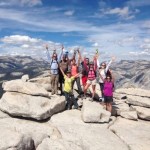
After Biodesign students explored Yosemite, Grand Canyon and the Mendocino coast, it was not uncommon for them to vow publicly (or privately) to return to one of the areas when they became adults. I have no record of how many achieved that goal, but I do know of one ex-student who has climbed Half Dome 8 times.
Therefore, I was not surprised when an ex-Biodesigner mentioned that he was joining a group that was going to retrace the hike that his class took over 20 years earlier.
His class rode a bus from Yosemite Valley to Glacier Point and as the bus approached Washburn Point, Half Dome loomed into view. I have seen that view approximately 40 times and each time it has left me breathless. The student responses were predictably gasps, oohs and aahs, however, on one occasion a student blurted out, “He’s freaking crazy if he thinks I am going to sleep up there!”
An orientation discussion included the major landmarks; Muir’s description that glaciation was the primary force that created Yosemite Valley and the current theory that Half Dome did not have another half, but was an atypically formed “pluton.”
After allowing time to absorb the sublime beauty, the group headed south, 1.4 miles to Illilouette Fall. Turning left at the waterfall, they ascended the Panorama Trail to Panorama Ridge.
[I agree with many veteran Yosemite hikers who regard the Panorama Trail as the most dramatic, and thus inspirational, trail in the entire Park. The trail is mostly level and the easier walk provides the opportunity to better appreciate the stunning new perspectives that appear around every bend.]
After approximately 2 miles the trail descended steeply downhill and joined the John Muir Trail, which originates in Yosemite Valley. A short walk to the top of Nevada Fall provided a great place to remove backpacks, relax and eat lunch. After a leisurely lunch, the students donned their backpacks and trudged 1.8 miles to their first trail campsite in Little Yosemite Valley.
The next morning, after breakfast and a briefing of the day’s activities, backpacks were hoisted and they began the challenging, 4-mile-hike up 2700 ft. to the top of the 8800 ft. Half Dome.
[A very dramatic narrative of climbing Half Dome can be found in, “Biodesign Out For A Walk,” chapter 6, “Cindy.”]
After sleeping on Half Dome, the group made the 10-mile descent back to their basecamp at Yosemite Valley.
After the ex-student returned, I contacted him with a request to hear about his adventure. He gladly obliged and filled me with wonderful stories and images. His group left their backpacks at Little Yosemite Valley and they hiked up Half Dome in time for a gorgeous sunset.
“It was a hard hike,” he said, “I don’t k now how our whole class made it with backpacks on.”
However, when I casually asked him how they handled the trail meals, he looked a bit sheepish and said, “Our guides took care of all of that.” I was not aware of such services, but quickly connected the dots and blurted out, “I HATE YOU!” Of course he knew that I was kidding and we shared a hearty laugh.
He obviously had not forgotten that a major chore for the Biodesign trips to Yosemite was preparing trail meals for a group of 30. Rather than packing 15 small backpack stoves, we took three MSR Rapidfire stoves. Each one sounded like a small jet airplane, but could get six quarts of water boiling in about 10 mins. We carried 3, 6-qt. pots and each pot provided enough hot water for 10 hikers.
He continued, “Only some of us had some equipment and rather than spend a lot of money on equipment that we would probably never use again, we hired two guides. They supplied all the equipment, cooked all meals on the trail and filtered all the water we needed.”
When I shared this with Christie, not unkindly, she burst out laughing and said, “I didn’t know that Yosemite had “Sherpa Guides!” LOL
My curiosity was piqued and so I went on-line to research “Yosemite Sherpa Services” (just kidding) and found a plethora of options available. The guide service that I Googled charged $900/per person for a three-day backpack trip similar to the one we took. At first, I was a bit shocked, but quickly recovered and concluded that the price was reasonable for what most participants would call, “a-once-in-a-lifetime-experience.” The $300/per day for guide, food and equipment seemed like a bargain compared to the $450/per night for a room at the Ahwahnee Hotel. Furthermore, it pleased me that our 6-day Yosemite trip cost our students $50. (with confidential scholarships readily available.) When I apologized to parents about the cost, they frequently dismissed my concerns and said their kids cost them more than that when they were at home. ;o)
John Muir hiked mostly alone at Yosemite and was happy with a single wool blanket and pillowcase with some dried bread balls and some tea. However, I truly believe that he would both approve and marvel at the evolution of the latest backpacking equipment and trail techniques, including professional guides. After all, he himself guided many Yosemite visitors, including President Teddy Roosevelt. Roosevelt was so impressed with Muir’s wilderness that, after returning to Washington D.C., he ordered 230 million acres to be protected and formed the foundation for the US National Park Service and the US Forest Service.
Sherpas in Yosemite? Why not?

